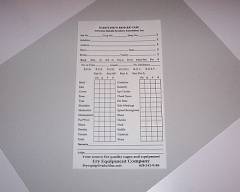 You’ve Seen Them – While comment cards vary a bit, and some clubs have been known to print off their own, they generally look like the one at the left. Cards used at Convention and perhaps Nationals do look a bit different, but you will have the same information on them.
You’ve Seen Them – While comment cards vary a bit, and some clubs have been known to print off their own, they generally look like the one at the left. Cards used at Convention and perhaps Nationals do look a bit different, but you will have the same information on them.
In some regions of the country, it is expected that you use the judge’s stamp to put the judge’s name on every card. Other places, this is not practiced. If you wish to play it safe, stamp them all. Otherwise, it might be a good idea to inquire, unless you already know the custom in that area.
Number In Class/Number of Exhibitors – Although it is subject to change, most writers will complete the number in the class and the number of exhibitors before the judge begins placing rabbits. These spaces are just below the section that the exhibitor completes. Remember that if not all rabbits show up, or if the judge finds a rabbit that is disqualified for something that reduces the number in the class (wrong variety, wrong sex, wrong class, etc.), or a rabbit is determined to be vicious or uncontrollable, the “No. in Class” and possible the “No. of Exhibitors” will be reduced.
Recording Awards – When the judge calls out the ear number, find the comment card, which you have spread out and probably sorted in some way that will help you find them easily. Make sure you say “okay” or somehow indicate to the judge that he or she may continue. You don’t want to lose time with each and every rabbit. Neither do you want the judge to get into the habit of beginning comments before you even have had time to find the card.
Don’t feel shy about politely asking others to talk more quietly so that you can hear the judge’s comments. Also, you may need to request that the judge bring rabbits down to your end of the table, or you may need to get closer to the judge to hear what she or he is saying. A professional judge will view you as part of the team and be willing to work things out so that you can hear the comments.
Write the award in the space between “No. in Class” and “No. Exhibitors” (DQ for disqualified, NP for no-placed, NS for no-show, S for Scratch, or a number if placed that way by the judge).
Recording Comments – Next record as many of the judge’s remarks as possible. For each characteristic, there is a column for very good, good, fair, and poor. It’s great when a judge uses those words. If not, you’ll have to do your best to interpolate.
It is most important to record any comments the judge makes about why the rabbit progressed as far as it did or how it was beaten. The comments that indicate the real differences are most important to record.
If you learn the order of the characteristics listed, it will be easier to write. I can never find them in time, so I jot down comments across the page or at the bottom where it says “Remarks.”
Always write down the reason for a disqualification in the remark area. If the judge mentions any area of concern (such as worn foot pads or genital redness), then mark that down in the remarks area, too.
Sometimes very good, good, etc. doesn’t really capture the essence of what the judge said. You may need to write words such as “narrow,” “flat,” “light,” or “long” across the boxes instead.
Multiple Copies – When you complete a card, peel off the back sheet and place it at the edge of the table for exhibitors to collect. When the judge places first place, leave the sheets together, since there may be further awards for that rabbit.
Keeping the first place comment card on top of the stack, lay the cards from the first class aside and continue until all of the classes have been completed or the judge stops to pick a special.
Specials – I find it helpful to just job down the specials on a sheet of paper. For example, I might put BOG: ssb, BOSG, sjd (Best of Group: solid senior buck, Best Opposite Sex of Group, solid junior doe). Then I can find those cards at my leisure. With breeds with few varieties, this may not be necessary, but when you have five varieties plus the opposite sex of each, you may have a lot of comment cards to accurately sift through in a short period of time. Jotting down the placements relieves the pressure to act quickly.
Circle the awards at the top of the page. After each rabbit has finished competition, you can then tear off the back sheet and make it available to exhibitors.
Balance of Time – There’s a compromise between keeping the show running and getting down enough comments so that the exhibitor gets an idea of why the rabbit placed as it did. Remember that getting the control sheet completed accurately is more important than the comment card.
